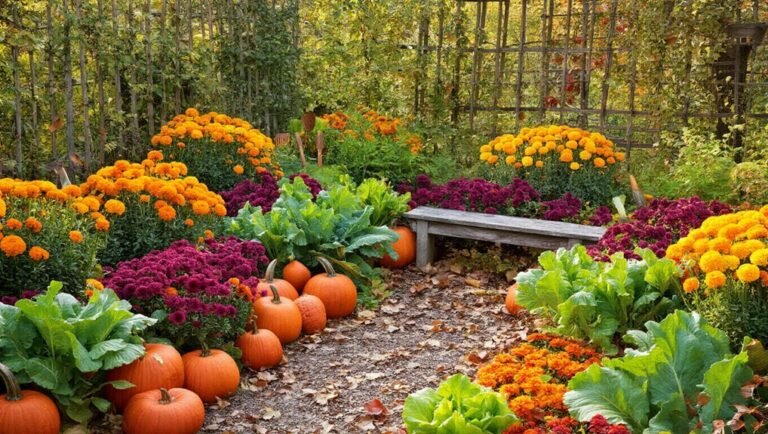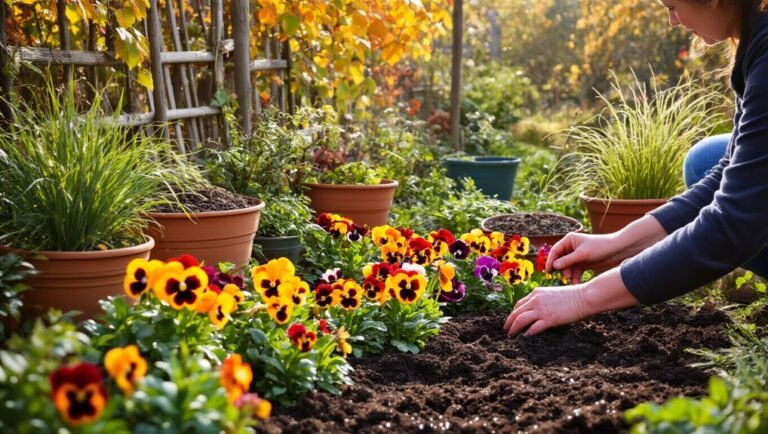To grow beautiful flowers, pick varieties that thrive in your climate and mix bloom times for continuous color. Understand your soil type and enrich it with compost for better drainage. Ensure your flowers get enough sunlight—you can check their specific needs. Water deeply but infrequently to encourage root growth. Don’t forget to prune and deadhead regularly. By following these simple tips, your garden will flourish, and there’s plenty more to discover about caring for flowers.
Key Takeaways
- Select flowers based on climate, sunlight exposure, and local hardiness zones for optimal growth.
- Test soil type and pH, enhancing it with organic matter for better drainage and nutrient retention.
- Water deeply but infrequently, and check soil moisture to prevent root rot; avoid watering during peak sunlight.
- Regularly prune faded blooms to encourage new growth and maintain plant health throughout the season.
- Incorporate companion planting to deter pests and improve flower growth through beneficial plant pairings.
Choosing the Right Flowers for Your Garden
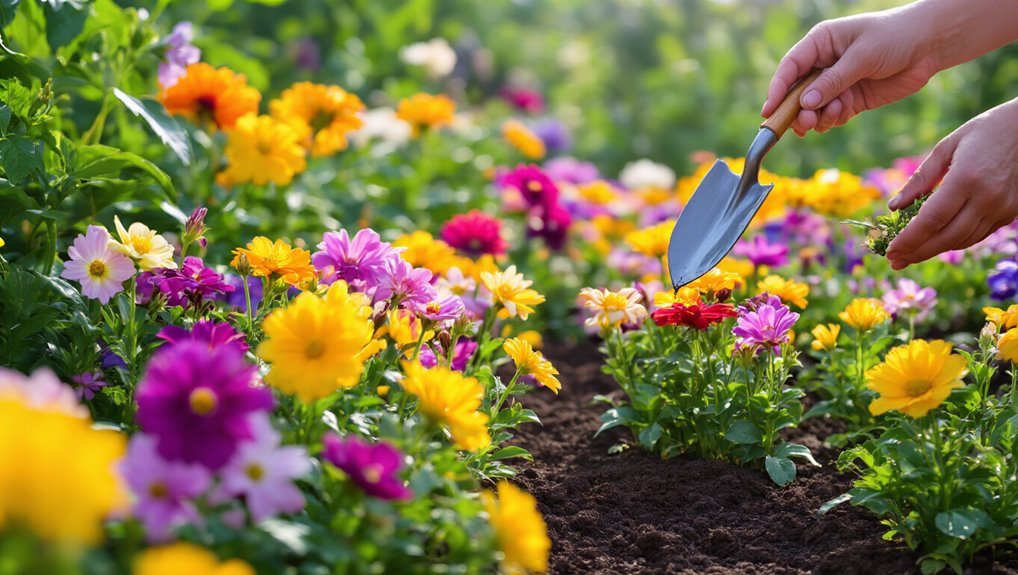
When it comes to choosing the right flowers for your garden, how do you know which ones will thrive in your space? Start by considering your climate and the amount of sunlight your garden receives. Some flowers love full sun, while others prefer shade.
Think about the colors you want; vibrant blooms can create a stunning focal point. Also, consider the bloom time; mixing early, mid, and late bloomers ensures continuous color. Adding decorative birdhouses can complement your flowers and provide a charming touch to your garden.
Check for your local hardiness zone to choose flowers that can withstand your temperatures. Don’t forget about maintenance—if you want low upkeep, opt for hardy perennials.
Finally, think about attracting pollinators; flowers like daisies and lavender can bring beneficial bees and butterflies to your garden.
For a unique and flavorful addition, consider growing edible flower seeds that can beautify your garden and also be used in a variety of dishes.
Understanding Soil Types and Preparation
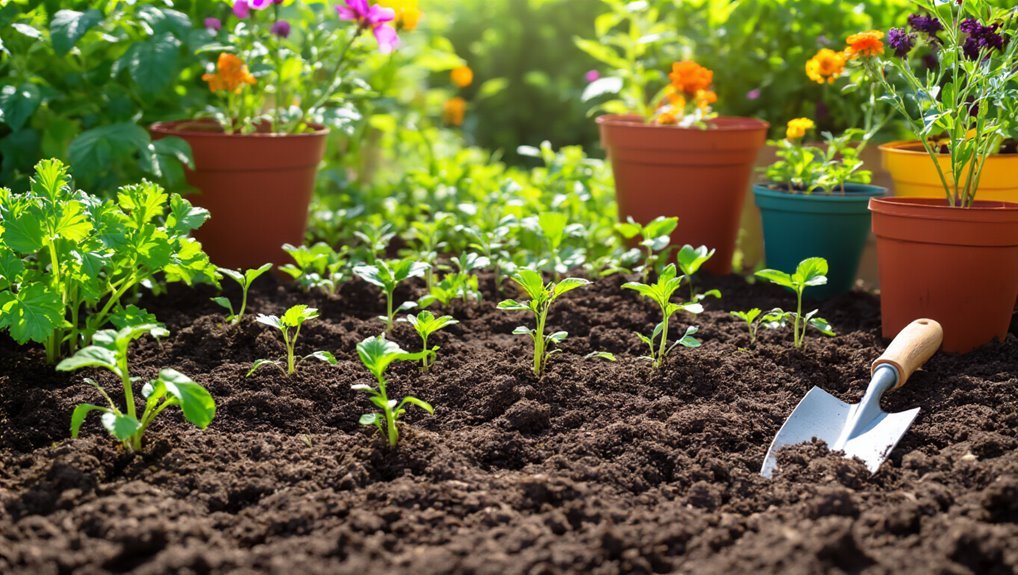
Selecting the right flowers is just the beginning; understanding soil types and preparing your garden beds is equally important for thriving plants.
Here’s a quick guide to help you prepare your soil effectively:
- Know Your Soil Type: Test if your soil is sandy, clay, or loamy. Each type has different drainage and nutrient-holding capabilities.
- Improve Soil Structure: Add organic matter like compost to enhance texture and fertility, promoting better root growth. Using outdoor composting systems can provide a steady source of organic material for your garden beds.
- Check pH Levels: Most flowers prefer slightly acidic to neutral pH. Use a kit to adjust as necessary.
- Aerate the Soil: Loosen compacted soil using a garden fork or tiller, allowing roots to penetrate easily.
For the best results, consider using compost bins to create nutrient-rich compost that will further boost your soil’s health and your flowers’ growth.
With proper preparation, you’ll create a thriving environment for your flowers to flourish!
Importance of Sunlight for Flower Growth
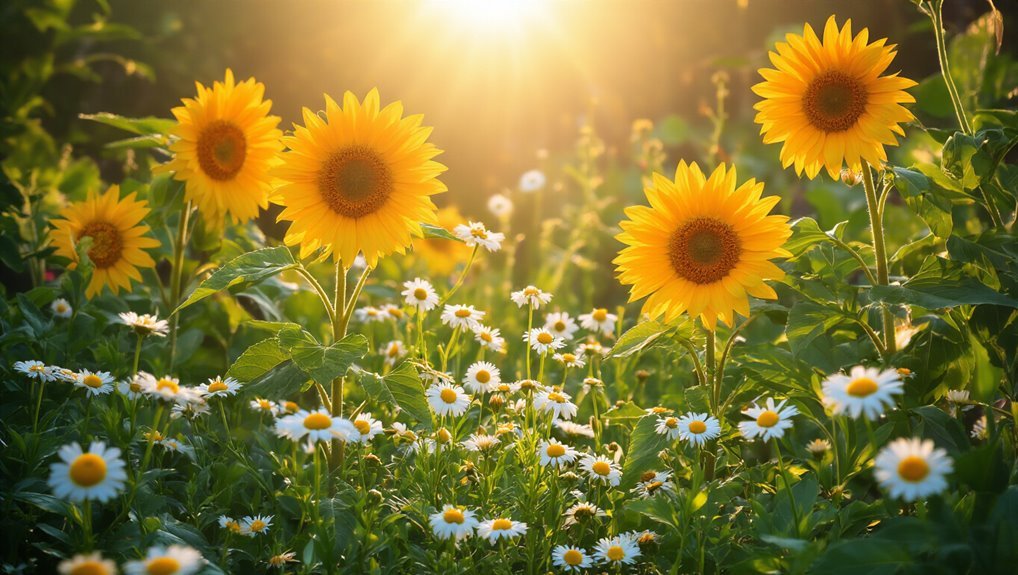
While you might focus on soil quality and watering, don’t underestimate the crucial role sunlight plays in flower growth. Sunlight is essential for photosynthesis, enabling your flowers to produce energy. Without adequate light, your blooms may become leggy or fail to thrive. In addition to sunlight, providing your garden with the best plant food options ensures your flowers receive the nutrients they need for robust growth.
Here’s a quick reference to help you understand sunlight requirements:
| Flower Type | Sunlight Needs |
|---|---|
| Sunflowers | Full sun (6-8 hours) |
| Impatiens | Partial shade (4-6 hours) |
| Marigolds | Full sun (6-8 hours) |
| Hostas | Full shade (2-4 hours) |
Additionally, consider using plant fertilizer tablets to further support your flowers’ growth and overall health.
Watering Techniques for Healthy Blooms
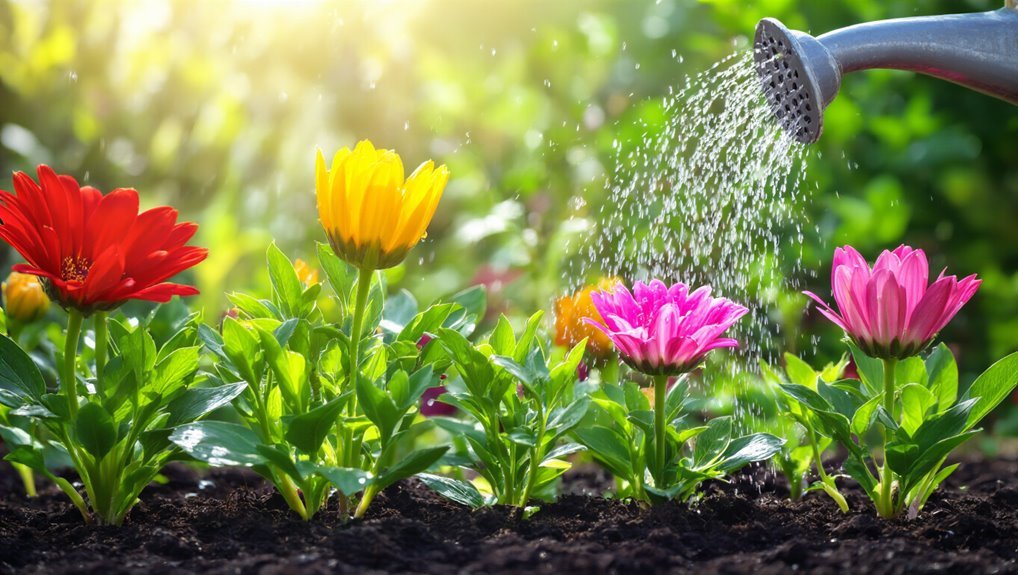
After ensuring your flowers receive the right amount of sunlight, the next vital aspect is watering. Proper watering techniques can make a significant difference in your blooms’ health and vibrancy. For the most efficient and thorough hydration, consider using garden hoses designed specifically for gardening needs.
Here are some tips to enhance your watering routine:
- Water early or late: Aim to water in the early morning or late afternoon to minimize evaporation.
- Use the right amount: Ensure the soil is moist but not soggy; overwatering can lead to root rot.
- Water deeply: Encourage deep root growth by watering thoroughly but less frequently.
- Check soil moisture: Stick your finger about an inch into the soil; if it’s dry, it’s time to water.
Using essential watering cans can also help deliver water exactly where your plants need it, making your watering routine more effective and efficient.
Fertilizing Your Flowers: When and How
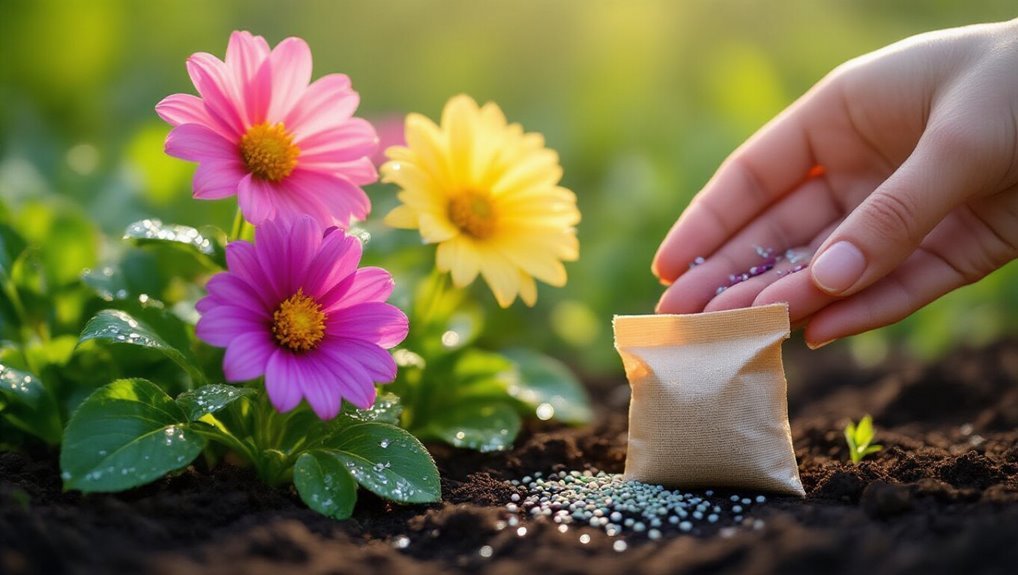
To ensure your flowers thrive and produce stunning blooms, understanding when and how to fertilize is crucial.
Start by choosing a balanced fertilizer, ideally one with equal parts nitrogen, phosphorus, and potassium. Fertilize your flowers in the spring when growth begins, and again mid-summer to support blooming. You can further enhance your flower beds by incorporating organic mulching materials like straw, which help conserve soil moisture and regulate temperature.
Use granular fertilizer by sprinkling it around the base of the plants, or opt for a liquid feed every four to six weeks. Always follow the package instructions to avoid over-fertilizing, which can harm your plants.
Water them thoroughly after fertilizing to help distribute the nutrients. Keep an eye on your flowers; if they’re growing weakly or their leaves turn yellow, it might be time to reassess your fertilizing routine.
For even better results, consider using mulch in your garden to help retain moisture, suppress weeds, and improve the overall health of your flower beds.
Pest Control: Protecting Your Garden
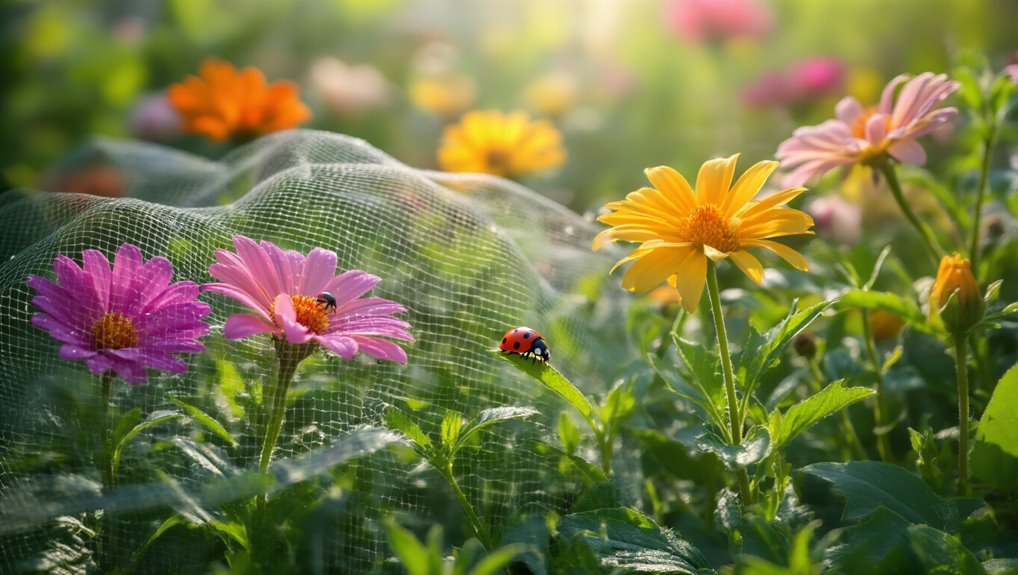
As you cultivate your beautiful flower garden, it’s essential to keep an eye out for pests that can undermine your hard work. Effective pest control ensures your flowers thrive instead of becoming lunch for unwanted visitors. Using Organic Pest Control Solutions can help you manage pests without introducing harmful chemicals into your garden.
Here are some easy tips to protect your garden:
- Inspect Regularly: Check your plants frequently for any signs of pest activity, such as holes or discoloration.
- Encourage Beneficial Insects: Attract ladybugs and lacewings, which naturally control pest populations.
- Use Organic Insecticides: Opt for neem oil or insecticidal soap to minimize harm to beneficial insects.
- Rotate Crops: Change your planting locations each season to disrupt pest life cycles.
You can also utilize pest control products designed for gardens to target specific pests while keeping your flowers safe and healthy.
Pruning and Deadheading for Continuous Blooms
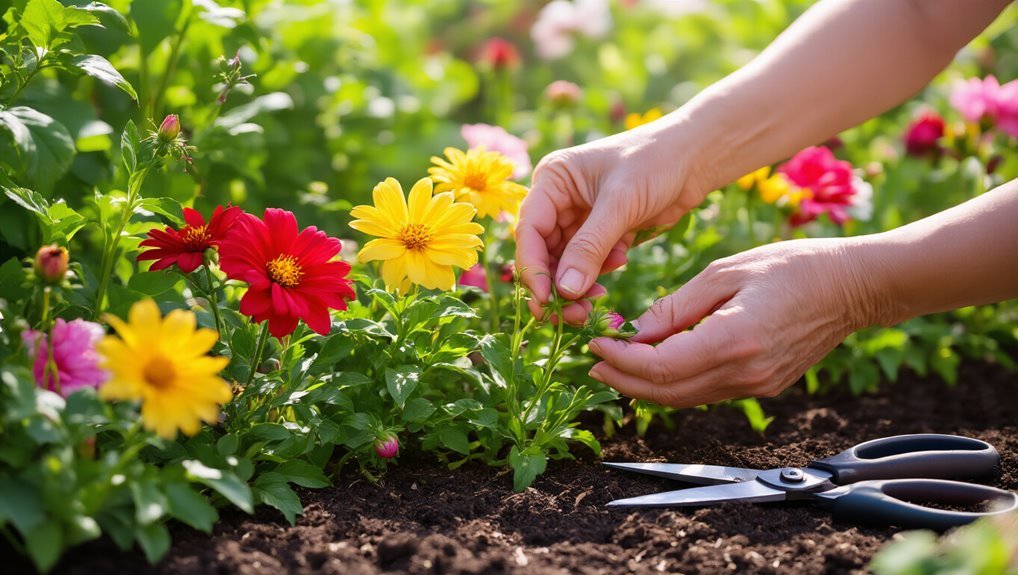
While you may be eager to enjoy the vibrant blooms in your garden, regularly pruning and deadheading your flowers is key to ensuring they continue to flourish.
Deadheading, or removing spent flowers, encourages plants to produce more blooms instead of focusing energy on seed production. Use clean, sharp scissors or pruners to snip off the faded flowers just above a leaf node. For this task, using a garden trowel can also help when loosening soil around the base of the plant to remove dead flowers or roots.
Pruning, on the other hand, involves cutting back stems to promote healthy growth and shape. Trim back leggy or overgrown plants in early spring or after flowering. This not only enhances appearance but also improves air circulation, reducing disease risk.
For the best results in your garden, investing in quality pruning shears can make these tasks easier and more effective.
Companion Planting for a Thriving Garden
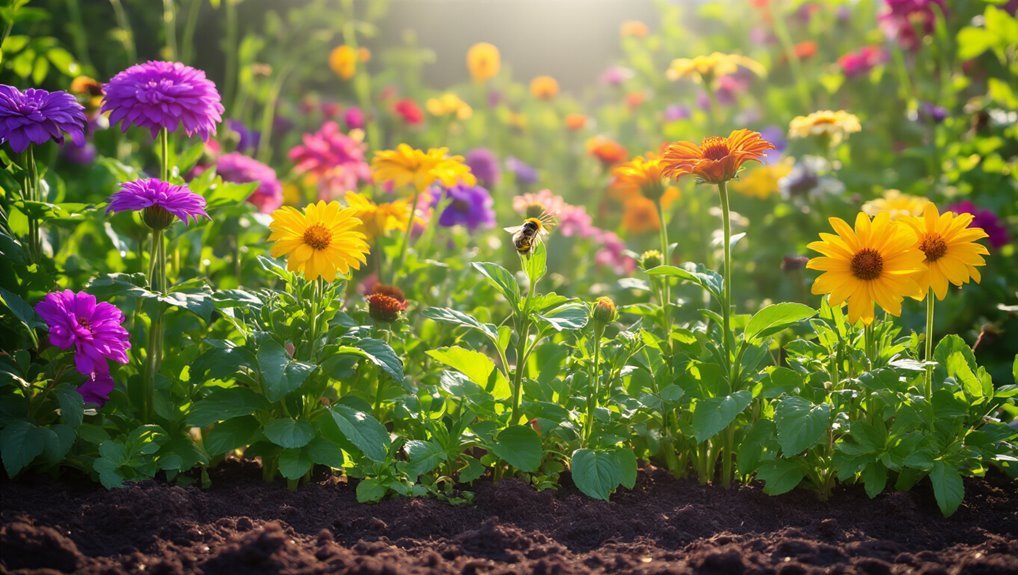
Companion planting can significantly enhance your garden’s health and productivity, especially when you choose the right pairings.
By strategically placing plants together, you can deter pests, improve growth, and boost yields. For best results, consider starting your plants indoors using one of these seed starting kits to ensure healthy seedlings ready for transplant. Here are four effective companion planting combinations to consider:
- Marigolds with Tomatoes – Marigolds repel nematodes and other harmful insects.
- Basil with Peppers – Basil enhances the flavor of peppers and repels whiteflies.
- Nasturtiums with Cabbage – Nasturtiums attract aphids away from cabbage, serving as a trap crop.
- Chives with Carrots – Chives deter carrot flies, promoting healthier carrot growth.
You can also include insect repellent plants like citronella in your garden design to naturally deter pests and support overall plant health.
Experimenting with these combinations can lead to a thriving garden, so don’t hesitate to try them out!
Seasonal Care Tips for Different Flower Types
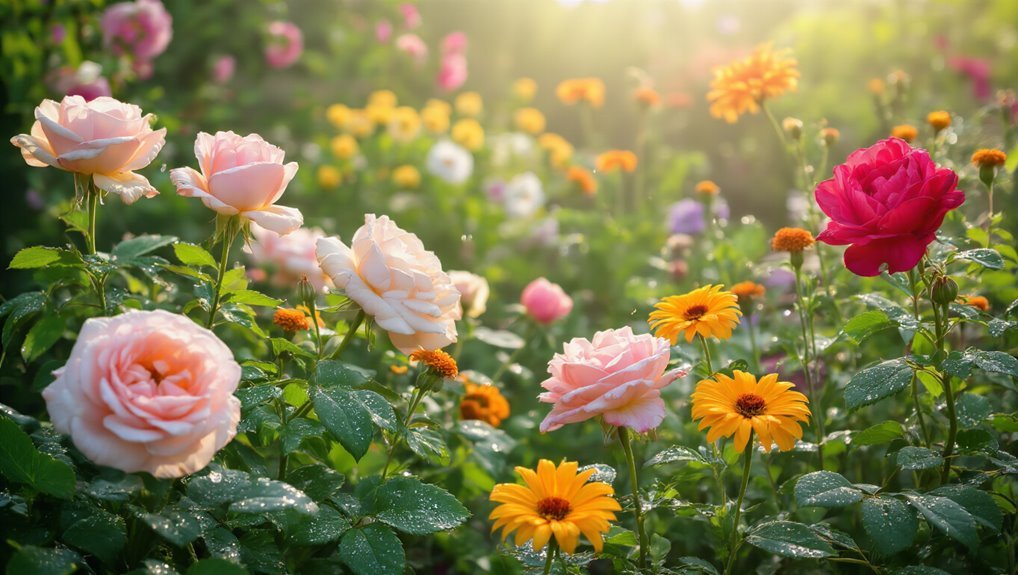
Understanding the seasonal care needs of your flowers can make all the difference in their growth and blooming potential.
For spring-blooming flowers like tulips and daffodils, ensure they get plenty of sunlight and regular watering as they emerge. Using a garden kneeler during planting and weeding can make these early-season tasks much more comfortable.
Summer bloomers, such as sunflowers and zinnias, thrive with consistent deadheading and a bit of fertilizer to support their vibrant growth.
In the fall, focus on perennials like asters and chrysanthemums; mulching can protect their roots as temperatures drop.
Lastly, winter care for dormant flowers, especially those in colder climates, involves covering them with mulch or burlap to shield them from harsh conditions.
Tailoring your approach based on the season will keep your flowers healthy and beautiful year-round.
Using the right hand rakes can make garden maintenance easier and more effective throughout each season.
Creating a Blooming Garden Layout
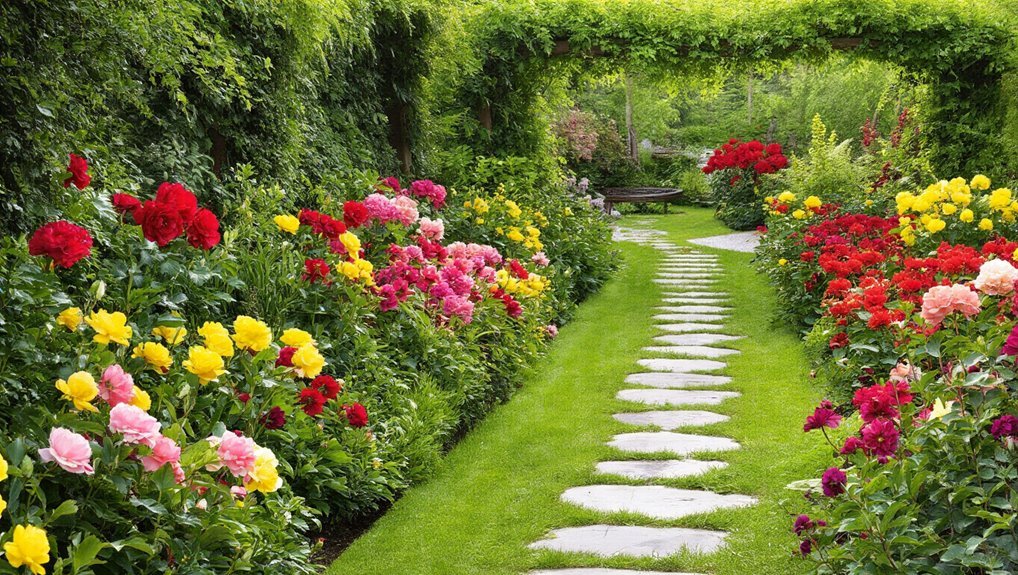
When you plan your garden layout, considering the height, color, and blooming times of your flowers can create a stunning visual impact. Adding Garden Trellis Netting can greatly support and enhance the growth of climbing flowers and vegetables in your layout.
Here are four tips to help you design a blooming garden:
- Layering: Position taller flowers at the back and shorter ones in front for depth.
- Color Schemes: Choose complementary colors to create harmony and interest.
- Bloom Times: Select a mix of early, mid, and late bloomers to ensure continuous color throughout the season.
- Focal Points: Incorporate unique plants or garden ornaments to draw the eye and create a focal point.
To support climbing plants and add vertical interest, consider adding beautiful trellises to your garden space.
Frequently Asked Questions
How Can I Attract Pollinators to My Flower Garden?
To attract pollinators to your flower garden, plant a variety of colorful, nectar-rich flowers, avoid pesticides, and create habitats with native plants. Also, consider adding water sources to encourage visiting insects and birds.
What Are the Best Times to Plant Flowers?
You wouldn’t plant flowers in a snowstorm, right? Ideally, you’ll want to sow seeds in spring after the last frost, or in fall for hardy varieties. Timing’s everything, so don’t rush the blooming!
How Do I Know if My Flowers Need More Nutrients?
You’ll know your flowers need more nutrients if their leaves turn yellow, growth stunts, or blooms drop prematurely. Regularly check soil health and consider using a balanced fertilizer to boost their vitality and promote healthy growth.
Can I Grow Flowers in Containers?
Absolutely! You can cultivate colorful blooms in containers. Choose the right potting mix, ensure proper drainage, and select suitable flowers. With a little care, your container garden will burst with beauty and vibrant life!
What Flowers Are Best for Attracting Butterflies?
To attract butterflies, consider planting lantana, asters, or coneflowers. These vibrant blooms provide nectar and create a welcoming habitat. Position them in sunny spots, and you’ll soon enjoy the flutter of colorful wings around your garden.
Conclusion
By following these easy tips, you’ll transform your garden into a vibrant tapestry of colors and scents. Remember, nurturing flowers is like cultivating a friendship; it takes patience and care, but the rewards are immeasurable. So roll up your sleeves and dive into the dirt! With the right approach, you’ll watch your blooms thrive and create a breathtaking oasis right in your backyard. Happy gardening, and may your flowers flourish like the sun after a storm!

